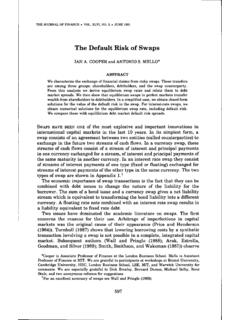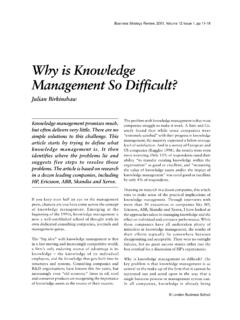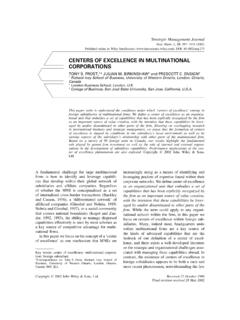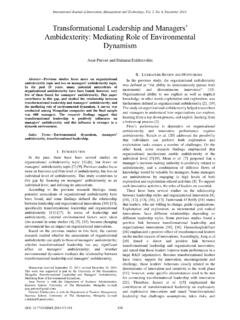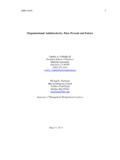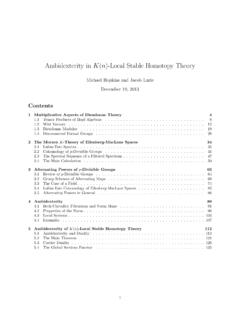Transcription of THE ANTECEDENTS, CONSEQUENCES, AND MEDIATING …
1 THE antecedents , consequences , AND MEDIATINGROLE OF organizational AMBIDEXTERITYCRISTINA B. GIBSONU niversity of California, IrvineJULIAN BIRKINSHAWL ondon Business SchoolWe investigated contextual organizational ambidexterity , defined as the capacity tosimultaneously achieve alignment and adaptability at a business-unit level. Buildingon the leadership and organization context literatures, we argue that a context char-acterized by a combination of stretch, discipline, support, and trust facilitates contex-tual ambidexterity . Further, ambidexterity mediates the relationship between thesecontextual features and performance. Data collected from 4,195 individuals in 41business units supported our recurring theme in a variety of organizationalliteratures is that successful organizations in a dy-namic environment areambidextrous alignedand efficient in their management of today s busi-ness demands, while also adaptive enough tochanges in the environment that they will still bearound tomorrow (Duncan, 1976; Tushman &O Reilly, 1996).
2 The simple idea behind the valueof ambidexterity is that the demands on an organi-zation in its task environment are always to somedegree in conflict (for instance, investment in cur-rent versus future projects, differentiation versuslow-cost production), so there are always trade-offsto be made. Although these trade-offs can neverentirely be eliminated, the most successful organi-zations reconcile them to a large degree, and in sodoing enhance their long-term have typically viewed ambidexterity instructural terms. According to Duncan (1976), whofirst used the term, organizations manage trade-offsbetween conflicting demands by putting in place dual structures, so that certain business units orgroups within business units focus on alignment,while others focus on adaptation (Duncan, 1976).
3 We refer to this asstructural , however, organizational scholars haverecognized the importance of simultaneously bal-ancing seemingly contradictory tensions and havebegun to shift their focus from trade-off (either/or)to paradoxical (both/and) thinking (Bouchikhi,1998; Earley & Gibson, 2002; Gresov & Drazin,1997; Koot, Sabelis, & Ybema, 1996; Lewis, 2000;Morgeson & Hoffman, 1999). Further, there is agrowing recognition of the role of the processes andsystems present in a given context in achieving thedesired balance between opposing demands. Theseprocesses and systems are important because theyprovide an alternative way of developing the capac-ities that architectures or structures are intended tocreate (Brown & Eisenhardt, 1997; Marks, Mathieu,& Zaccaro, 2001).Combining these insights, we develop the con-cept ofcontextual ambidexterity contextual be-cause it arises from features of its organizationalcontext.
4 Contextual ambidexterity is the behavioralcapacity to simultaneously demonstrate alignmentand adaptability across an entire business refers to coherence among all the pat-terns of activities in the business unit; they areworking together toward the same goals. Adaptabil-ity refers to the capacity to reconfigure activities inthe business unit quickly to meet changing de-mands in the task environment. By their nature,such capacities are complex, causally ambiguous,widely dispersed, and quite time-consuming to de-We would like to thank the editor, three anonymousreviewers, James O Toole, Mary Zellmer-Bruhn, and PaulTesluk for their helpful suggestions. We also wish toacknowledge the financial support of Booz Allen Hamil-ton, and the substantive contributions made by the firm sBruce Pasternack, Tom Williams, and Karen Van Nuys,as well as by the researchers and staff at the Center forEffective Organizations.
5 Earlier versions of this paperwere presented at the 2000 conference of the Academy ofInternational Business (2000) and the Academy of Man-agement 2001 annual would like to thank Marshall Schminke, Associ-ate Editor of theAcademy of Management Journal, forhelping us to clarify the distinction between structuralambidexterity and contextual ambidexterity . Academy of Management Journal2004, Vol. 47, No. 2, 209 (Amit & Schoemaker, 1993; Barney, 1991;Prahalad & Hamel, 1990).The concept of contextual ambidexterity differsmarkedly from the traditional concept of structuralambidexterity because the former is best achievednotthrough the creation of dual structures, but bybuilding a set of processes or systems that enableand encourage individuals to make their own judg-ments about how to divide their time between con-flicting demands for alignment and adaptability(Duncan, 1976; McDonough & Leifer, 1983; Tush-man & O Reilly, 1996).
6 Further, rigorous systematicevidence documenting the success of ambidextrousorganizations is lacking, and there has been verylittle detailed investigation of how organizationsactually achieve ambidexterity (Adler, Goldoftas, &Levine, 1999). Thus, the purpose of this study wasto empirically investigate the antecedents andconsequences of organizational contextual build on the organization-context literature,in particular Ghoshal and Bartlett s (1994) frame-work for organizational effectiveness, to suggestthat contextual ambidexterity emerges when lead-ers in a business unit develop a supportive organi-zation context. According to this perspective, supe-rior business-unit performance is not achievedprimarily through charismatic leadership, northrough a formal organization structure, nor eventhrough a strong culture.
7 Rather, it is achieved bybuilding a carefully selected set of systems andprocesses that collectively define a context thatallows the meta-capabilities of alignment andadaptability to simultaneously flourish, and therebysustain business-unit performance. These relation-ships are depicted in Figure the body of this article, we develop this argu-ment in greater detail. We first elaborate the con-cept of contextual ambidexterity and establish itsvalue by examining its relationship with perfor-mance. Next, we address the contextual anteced-ents of such ambidexterity . Finally, we propose themanner in which contextual ambidexterity medi-ates the relationship between context and perfor-mance. We tested our hypotheses on an extensivebody of data covering 4,195 individuals in 41 busi-ness units.
8 In the latter sections of the article, wepresent and discuss our empirical ambidexterity INORGANIZATIONST raditionally, in the organizational literature am-bidexterity refers broadly to an organization s abil-ity to pursue two disparate things at the sametime such as manufacturing efficiencyandflexi-bility (Adler et al., 1999; Carlsson, 1989), differen-tiationandlow-cost strategic positioning (Porter,1980, 1996), or global integrationandlocal respon-siveness (Bartlett & Ghoshal, 1989). More specifi-cally, the ambidextrous organization achievesalignment in its current operations while alsoadapting effectively to changing environmentaldemands. For example, Tushman and O Reillydefined ambidexterity as the ability to simulta-neously pursue both incremental and discontinu-ous innovation and change ( 1996: 24); Duncan(1976) focused on the need for organizations todevelop dual structural arrangements for managinginnovation; and March and Simon (1958) discussedthe balance between the conflicting demands forexploitation and , there has been some discussion as towhether internal organizational tensions, such asthose between alignment and adaptability, can everbe effectively reconciled (Ford & Ford, 1994; Lewis,2000).
9 Porter (1996), for example, argued that thetrade-off between low-cost and differentiated posi-tions is insurmountable, so that organizations haveto make explicit choices. And in research on man-ufacturing, the trade-off between efficiency andflexibility has been viewed as inherent to the man-ufacturing process (Carlsson, 1989; Ghemawat &Costa, 1993; Hart, 1942; Klein, 1984). Proponents ofthis point of view typically have argued that trade-offs are best managed through structural separa-tion for example, hiving off new business de-velopment in a separate unit (Drucker, 1985;Galbraith, 1982), or creating autonomous businessunits (Tushman & O Reilly, 1996: 25). Such struc-tural separation ensures that each organizationalunit is configured to the specific needs of its taskenvironment (Burns & Stalker, 1961; Lawrence &Lorsch, 1967), but it creates coordination second perspective on ambidexterity that hasappeared in the literature is the idea that organiza-tions can create structures and systems to reconcileFIGURE 1 Relationships Predicted210 AprilAcademy of Management Journalseemingly contradictory tensions.
10 For example, inthe manufacturing literature flexibility and cost-efficiency are no longer thought of as contradictory(de Meyer, Nakane, Miller, & Ferdows, 1989; Mac-Duffie, 1995). Achieving both may involvetaskpartitioningwithin a single business unit, whereby,for example, one group adopts an organic struc-ture while another takes on a mechanistic struc-ture (Adler, Goldoftas, & Levine, 1999; Hedlund &Ridderstrale, 1997; McDonough & Leifer, 1983).Another structural solution put forth istemporalseparation,a system in which an entire unit fo-cuses on one set of tasks one day, then on a differ-ent set of tasks the next (Adler et al., 1999; Duncan,1976; McDonough & Leifer, 1983). Both these ap-proaches allow the competing demands for adapt-ability and alignment to be met within a singlebusiness unit (which removes many of the coordi-nation costs noted above), but they still rely onstructural solutions that require unit managers tojudge how best to divide up work groups and/orperiods of time to meet those different needs.

